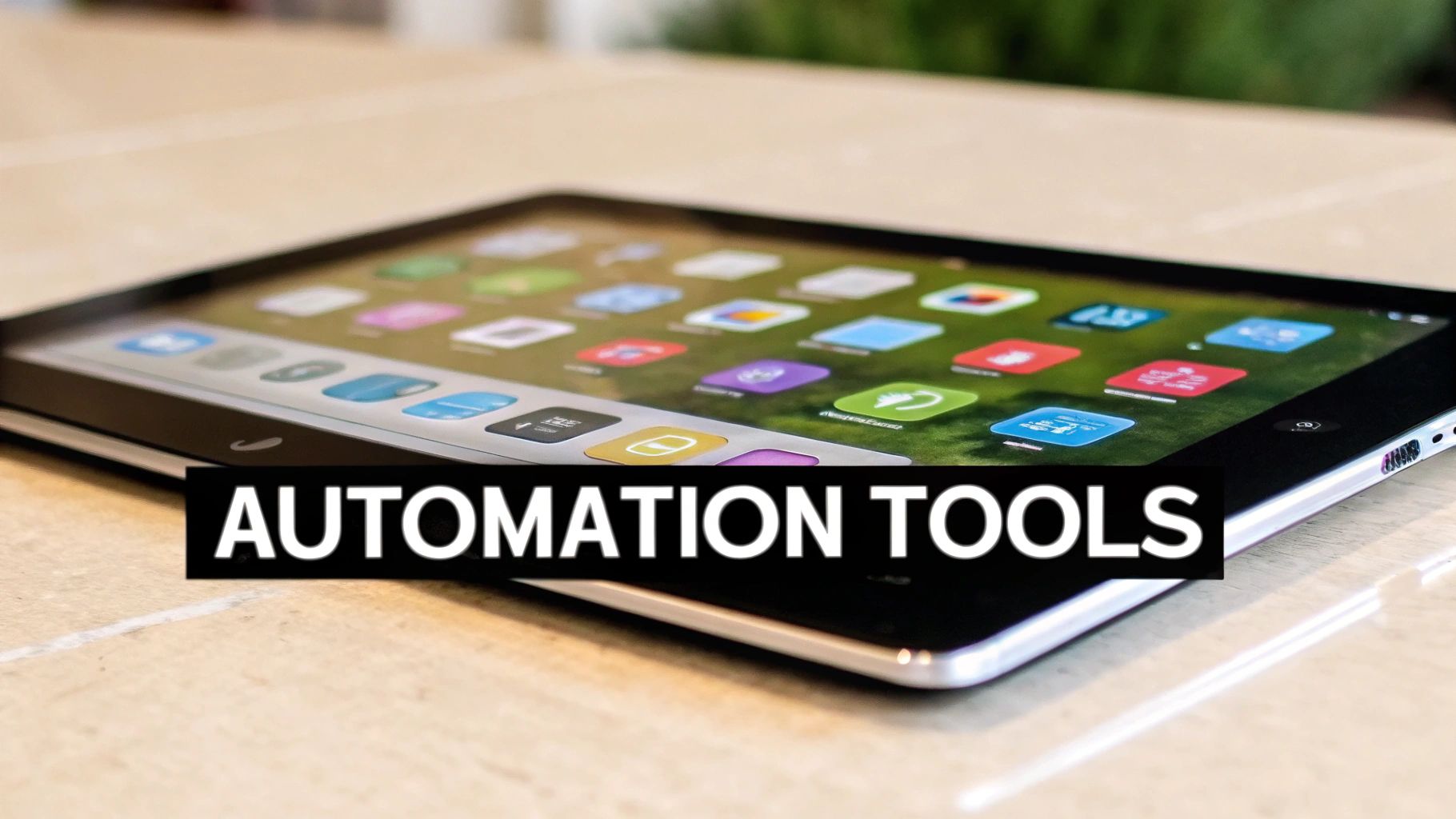Let's be honest, content creation is a grind. Your team is brilliant, but even brilliant people get bogged down by the endless, repetitive tasks that come with feeding the content machine. This is where content automation comes in, not as a replacement for your creative minds, but as a powerful assistant that takes the tedious work off their plates.
Think of it this way: instead of your writers and strategists getting stuck on grunt work, they can focus on what they do best—coming up with big ideas and crafting compelling stories. It's all about working smarter, not just harder.
Why Content Automation Is No Longer Optional
In a world that demands a constant flow of high-quality content, trying to do everything by hand is a recipe for burnout and inconsistent results. Manual processes just can't keep up. Content automation steps in to handle the entire lifecycle, from the initial spark of an idea all the way to getting it in front of your audience.
Imagine your team needs to get a blog post out every week. The old-school way looks something like this:
- Hours spent brainstorming topics.
- More hours on keyword research.
- Staring at a blank page to write the first draft.
- Scrambling to find or create visuals.
- Painstakingly optimizing for SEO.
- Manually scheduling social media posts for every single platform.
It’s slow, exhausting, and nearly impossible to scale.
Now, picture an automated workflow. An AI tool can instantly generate a list of trending topic ideas. A smart template can structure the first draft, giving your writer a running start. A scheduler can then automatically push the finished article to your blog and social channels at the perfect time. The difference is night and day.
The Marketing World Has Already Made the Switch
This isn't some futuristic trend; it's happening right now. The move toward efficiency has fundamentally changed marketing strategy. As of 2025, tech-driven marketing is the new standard, with an estimated 77% of marketers already using AI-powered automation to create personalized content.
This massive adoption is fueling the marketing automation market, which is on track to hit $15.62 billion by 2030. The numbers don't lie—automation is here to stay.
To give you a clearer picture, here’s a quick comparison of the old way versus the new way:
Manual vs. Automated Content Workflows
| Task | Manual Approach (Time/Effort) | Automated Approach (Time/Effort) |
|---|---|---|
| Topic Research | 2-4 hours of manual trend analysis | <15 minutes with AI-driven topic generation |
| First Draft | 3-6 hours from a blank page | 1-2 hours starting from an AI-generated outline |
| Visual Creation | 1-3 hours searching or designing | <30 minutes using AI image generators |
| SEO Optimization | 1-2 hours of manual keyword placement | <20 minutes with real-time AI suggestions |
| Distribution | 1-2 hours scheduling on each platform | <10 minutes with a one-click scheduler |
The time and effort saved are staggering, freeing up your team for more strategic initiatives.
The core idea is simple: Automation handles the process, freeing up humans to perfect the product.
This approach ensures your brand voice stays consistent and your publishing schedule never misses a beat. You can reach a wider audience without ever sacrificing the quality they've come to expect from you.
This is especially critical for anyone trying to make their content more engaging and shareable. That’s why tools that can quickly turn simple notes into eye-catching visual assets are becoming so essential. For a great example of this in action, see how innovative tools like TNote are using md2card magic to make content repurposing ridiculously fast.
By embracing automation, you’re not just saving time; you’re building a content engine that’s resilient, scalable, and ready for whatever comes next.
The Real Benefits of Adopting Content Automation

Knowing what content automation is gets you in the door. But seeing the real-world benefits is what makes you want to stay. Adopting automation isn't just about cranking things out faster; it’s about a fundamental upgrade to how your team functions. The advantages build on each other, turning your content efforts into a powerhouse.
These benefits really boil down to three core pillars: efficiency, consistency, and scalability. Each one hits a classic sore spot that manual workflows always seem to create, offering a clear way to work smarter, not just harder.
Supercharge Your Team’s Efficiency
Think of your content team as a crew of expert chefs. Automation is like having the perfect kitchen staff that handles all the grunt work—the chopping, the cleaning, the organizing. This lets your chefs focus on what they do best: creating incredible meals.
In the marketing world, that translates to automating tasks like:
- Data Gathering: Automatically pulling analytics and performance stats for reports.
- Social Media Scheduling: Setting up weeks of social posts in a few minutes instead of a few hours.
- Content Formatting: Applying your brand's templates and styles to raw drafts in an instant.
By taking these repetitive chores off their plate, content automation frees up your team's creative bandwidth. They get to spend less time on administrative busywork and more time on what actually moves the needle—strategy, brainstorming, and connecting with your audience.
Maintain Rock-Solid Brand Consistency
A fragmented brand voice is confusing. It waters down your message and erodes trust. Keeping everything consistent is a huge challenge, especially when you have multiple people creating content for different channels.
This is where automation steps in as your brand's ever-vigilant guardian. By locking in templates, style guides, and workflows, you make sure every single piece of content—from a detailed blog post to a quick tweet—sticks to the same rules. It guarantees a uniform tone, message, and look, regardless of who's hitting the publish button.
An automated system ensures your brand speaks with one voice, every single time. It turns brand guidelines from a static PDF that nobody reads into an active, living part of your workflow.
Scale Your Content Without Scaling Your Budget
This might just be the biggest win of them all. You always want to produce more content to find new audiences and keep your current ones engaged, but your budget and team size aren't exactly infinite. Content automation breaks that old-school link between how much you create and how much it costs.
It’s no surprise that marketing teams are embracing automation 76% more than sales teams and a whopping 139% more than finance teams. The results speak for themselves: over 90% of workers say automation makes them more productive, which translates directly to major operational savings. For a deeper dive, you can explore additional marketing automation stats to see the full picture.
With the right tools in your corner, you can churn out a higher volume of personalized, targeted content without having to hire more people or beg for more budget. This means you can run more campaigns, test out more ideas, and grow your reach in ways that would be completely out of reach with a purely manual setup.
Exploring the Main Types of Automation Tools

The world of content automation can feel vast and a bit overwhelming, but it doesn't have to be a confusing maze. The best way to get a handle on it is to think of the different tools as specialists in a workshop. Each one is designed for a very specific job. Instead of getting bogged down by brand names, let's group these tools by the problems they actually solve in your day-to-day content workflow.
This approach helps you zero in on exactly where your process has friction and which type of tool will give you the most bang for your buck, right away. Most tools fall into one of four key categories, each playing a unique part in the content lifecycle.
Content Generation and Ideation Tools
This is where the creative spark gets a serious technological boost. These tools are built to conquer the two biggest hurdles in content creation: the dreaded blank page and the endless hunt for fresh, relevant topics. Think of them as your creative co-pilot.
Their main job is to kickstart the whole process. Instead of you spending hours brainstorming or manually digging through keyword data, these platforms do the heavy lifting.
- AI Writers: These can whip up outlines, draft entire paragraphs, or even spit out a complete first draft from a simple prompt. They're perfect for busting through writer's block and dramatically speeding up that initial production phase.
- Topic Generators: By analyzing search trends and what your competitors are writing about, these tools suggest high-potential topics that your audience is actively searching for.
Content Optimization Tools
Once you have a draft, the next step is to polish it for maximum impact. Optimization tools are like your personal quality control inspectors, making sure your content is professional, easy to read, and primed for search engine success.
These platforms analyze your text as you write, offering data-driven suggestions to improve its performance. They bridge the gap between just good writing and content that actually drives results.
These tools don't just check for typos. They analyze structure, keyword density, and readability to make sure your message lands with both humans and search algorithms.
For example, an SEO analyzer will point out opportunities for better keyword placement, while a readability tool will flag sentences that are too convoluted, helping you write clearer, more engaging content.
Content Management and Curation Tools
As your library of content grows, organization becomes absolutely critical. This group of tools acts as your digital librarian and project manager, keeping all your assets and schedules in perfect order. They are the central nervous system of any content strategy that’s built to scale.
From storing brand assets to mapping out your publishing calendar, these tools prevent chaos from taking over. The market for Content Automation AI Tools has exploded because businesses need reliable systems to handle ever-increasing content demands. These tools automate tedious organizational tasks, improving consistency and cutting down on manual work. You can find more insights on the rise of these AI tools on markwideresearch.com.
Content Distribution and Analytics Tools
Creating great content is only half the battle; the other half is getting it in front of the right people. Distribution and analytics tools automate the final, crucial steps of publishing your content and measuring how well it does. They're your automated delivery drivers and data scientists, rolled into one.
This category includes:
- Social Media Schedulers: These let you plan and automate posts across multiple platforms, all from a single dashboard.
- Email Marketing Platforms: They automate the job of sending out newsletters and targeted campaigns to your subscriber lists.
- Analytics Dashboards: These tools automatically pull in performance data, showing you what’s working and what’s not, so you can make smarter decisions about your strategy.
How to Build Your First Automation Workflow

Alright, let's move from theory to action. Building your first content automation workflow is probably easier than you imagine. The secret is to start small with a clear, achievable project that shows you just how powerful it is to connect a few different tools.
We'll map out a simple but effective workflow for churning out a weekly blog post. This example connects several specialized tools, each tackling a specific part of the process, turning what used to be hours of manual work into a slick, automated system.
Step 1: Start with AI-Powered Ideation
Every great piece of content starts with an idea. But instead of staring at a blank page, you can use an AI topic generator to find high-potential subjects your audience is already looking for. Just feed it a broad topic, and within minutes, you’ll get a list of relevant, data-backed ideas.
Step 2: Draft with Intelligent Templates
Once you've landed on a topic, it's time to get a first draft down. This is where you can reclaim a massive amount of time. Instead of writing from scratch—a process that can easily eat up hours—you can use an AI writer to generate a structured outline or even a full initial draft based on your topic and keywords.
Many writers use this as a fantastic jumping-off point. For those who like a more hands-on approach, a dedicated editor can still speed things up. For instance, you can use specialized tools to quickly turn your Markdown notes into polished drafts. Playing around with something like the TNote editor can make drafting and formatting surprisingly efficient.
Pro Tip: Your initial automated draft is not the final product. Think of it as a perfectly prepped set of ingredients. Your job is to be the chef—the one who adds the unique flavor, personal insights, and brand voice that only a human can.
Step 3: Refine with SEO and Quality Tools
With a solid draft in hand, the next step is optimization. This is where automation really flexes its muscles by taking all the guesswork out of SEO and quality control.
- SEO Refinement: Run your draft through an SEO tool like Yoast or Rank Math. It’ll scan your text and give you real-time suggestions for keyword placement, heading structure, and meta descriptions to help you climb the search rankings.
- Readability Check: Use a tool like Grammarly to catch any grammar slip-ups and check for style and clarity. This ensures your final piece is professional and a breeze for your audience to read.
Step 4: Schedule and Distribute Automatically
The final leg of the journey is getting your polished content out into the world with as little effort as possible.
- CMS Scheduling: Upload the final article to your Content Management System (CMS) like WordPress. But instead of hitting "publish" right away, schedule it to go live at the best time for your audience.
- Automated Social Sharing: Use a tool like Buffer or Hootsuite to automatically share your new post across all your social media channels the second it's published.
- Email Newsletter Trigger: Configure your email marketing platform to automatically fire off a newsletter to your subscribers, letting them know a new post is live.
By connecting these simple stages, you create a seamless production line for your content. This workflow transforms a complex, multi-day headache into a manageable and consistent process, freeing you up to focus on the bigger picture—like strategy and growth.
TNote's md2card Magic: Advanced Automation in Action
Standard content automation tools are great for the simple stuff, like drafting an article or scheduling a post. They handle linear tasks well. But what if you could take a single piece of content and, with one click, splinter it into a dozen different formats? That's not just an improvement—it's a massive leap in efficiency.
Imagine you just finished writing a detailed article or some study notes in Markdown. It’s a clean, simple text format loved by writers and developers for a reason. Now, what if you could instantly transform that text into a polished slide deck, a stack of flashcards for studying, and a perfectly threaded series of tweets? All from that one original document.
This is the real power of multi-output automation. It's about maximizing your content's reach and impact without multiplying your workload.
How TNote Turns Your Text Into Visuals Instantly
TNote’s md2card feature is a perfect example of this kind of smart automation. It was built specifically to close the gap between your plain text notes and sharp, visually engaging assets. Forget the tedious copy-paste routine into different design apps; md2card handles all the heavy lifting.
- One Source to Rule Them All: Your Markdown file is the central hub. Need to make a change? Update it once, and you can regenerate all your visuals in seconds.
- Repurpose Like a Pro: Create different formats for different platforms. Think slides for a LinkedIn presentation, square cards for an Instagram carousel, or flashcards for your class—all from the same text.
- Stay on Brand, Automatically: Use preset themes to make sure every single visual asset has a consistent look and feel. It’s the easiest way to strengthen your brand identity without even trying.
Here’s a quick look at how the md2card workflow turns a simple Markdown file into something much more.
The screenshot says it all. On the left, you have your raw Markdown text. On the right, it’s instantly rendered into a clean, shareable card. This "one-click" magic is what makes it so efficient. It completely cuts out the need for separate design tools or hours spent on manual formatting. It's a prime example of practical content automation that saves you time while making your information look incredible.
For creators and educators, this is a game-changer. It means less time stuck in design busywork and more time focused on what you do best: creating valuable content. When you can visualize ideas instantly, the information becomes far more digestible and shareable.
This approach is especially powerful for students building study guides, developers sharing code snippets, or marketers whipping up social media carousels. It automates the final, most visual step of creation, guaranteeing your ideas don't just read well—they look great, too.
You can see more examples and try the md2card magic for yourself at TNote. This one feature shows just how far modern automation has come, evolving from a simple task-doer into a genuine creative partner.
Best Practices for Implementing Automation

Jumping into content automation without a real plan is like trying to build a performance engine without the instructions. You might get a few parts to fit, but it's not going to run. To build a system that actually works for you long-term, you need a solid framework based on what we know works in the real world.
The most common mistake I see teams make? They try to automate everything at once. This almost always leads to a messy, frustrating process that gets abandoned before it ever has a chance to deliver results. A much better approach is to start small and scale smart.
Find one single, mind-numbingly repetitive task in your current workflow. Maybe it's scheduling all your social media posts or pulling basic data for a weekly report. Automate that one thing first. This gives you a quick, tangible win and proves the concept to your team without overwhelming everyone.
Maintain the Human Touch
Think of automation as the world's best assistant, not a replacement for your team's expertise. Its real value is in taking over the tedious, soul-crushing parts of the job. This frees up your creative people to focus on strategy, storytelling, and nailing the brand voice—the stuff only a human can truly get right.
Always keep a human in the loop for the final review. This is non-negotiable. It’s what ensures your content feels authentic, sounds like your brand, and doesn't have that robotic, off-putting vibe that can kill engagement.
This "human-in-the-loop" model is the gold standard for quality content automation. You get the speed and efficiency of machines combined with the irreplaceable nuance of human insight. It's truly the best of both worlds.
Build an Integrated and Agile System
For your workflow to be truly seamless, your tools have to talk to each other. When you're picking out software, make interoperability a top priority. Can your AI writer send a draft directly to your SEO tool? Does your scheduler connect with your CMS without a bunch of manual workarounds?
Finally, you have to treat your automation setup like a living, breathing system. This isn't a "set it and forget it" project. To make sure you’re getting the most out of your investment, you need to:
- Continuously Monitor: Keep a close eye on your performance data. Are your automated posts actually getting engagement? Is the workflow saving you as much time as you thought it would?
- Refine and Adjust: Use what you learn from the data to tweak your processes. You might find a better prompt for your AI writer or discover a more effective time to schedule your content.
By taking this iterative approach, you ensure your automation strategy doesn't just get implemented—it evolves and improves over time, driving consistently better results for your business.
Still Have Questions About Content Automation?
Jumping into content automation is exciting, but it’s natural to have a few questions pop up. It’s a big shift, after all. Let's walk through some of the most common ones I hear from teams just getting started.
Will My Content Sound Like a Robot Wrote It?
That's a fair concern, but the short answer is no—not if you do it right. The trick is to think of automation as a brilliant research assistant, not the final author. Let it handle the grunt work, like digging up stats, structuring an outline, or even cranking out a rough first draft.
The magic happens when a human—that’s you—steps in to add the final strategic polish, inject your brand's unique voice, and ensure the message truly connects. This "human-in-the-loop" approach is the secret to keeping your content authentic and miles away from that generic, robotic feel.
Isn't This Stuff Too Expensive for a Small Business?
Not at all. In fact, the market is packed with tools built for every kind of budget. You'll find plenty of powerful options with generous free plans or low-cost tiers to get you going.
The best way to start is to think small. Pick just one high-impact, repetitive task to automate. The time you claw back often delivers a return on investment so clear that it pays for the tool itself, letting you scale up as you grow.
Where’s the Best Place to Even Begin?
Start by finding your biggest time-drain. Pinpoint the single most repetitive, mind-numbing content task on your plate. For many, that's scheduling a week's worth of social media posts or compiling data for those basic performance reports.
Automating just that one thing gives you an immediate, satisfying win. You’ll instantly see the value of content automation and free up mental energy to tackle more creative, high-impact work.
Ready to turn your notes into stunning, shareable visuals in a snap? With TNote, you can transform simple Markdown text into beautiful cards for social media, presentations, and study guides with just one click. Discover the magic of md2card and make your content unforgettable.